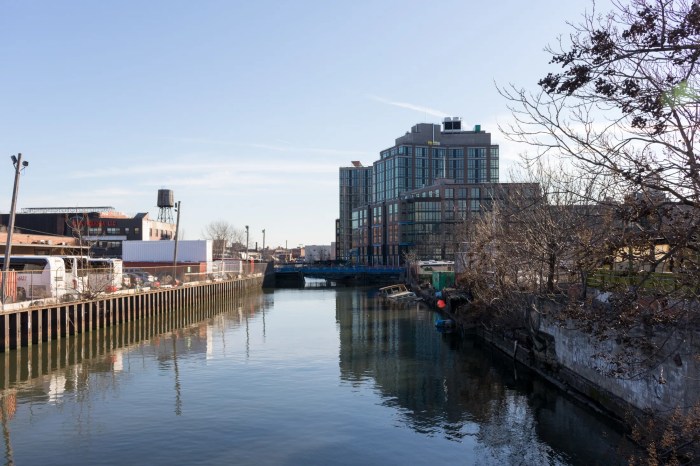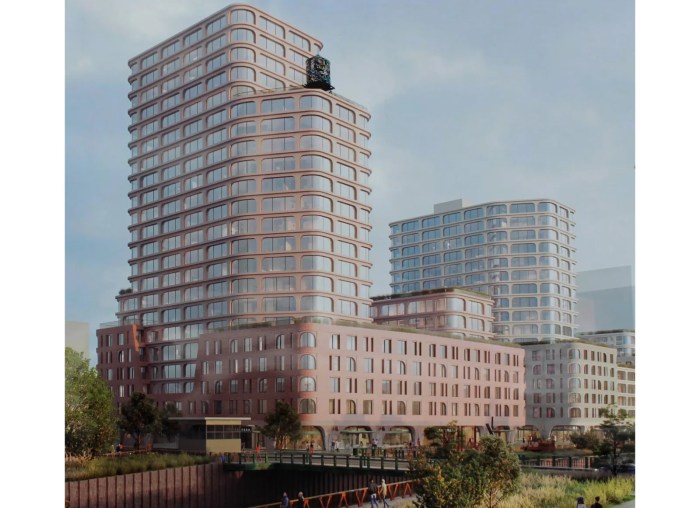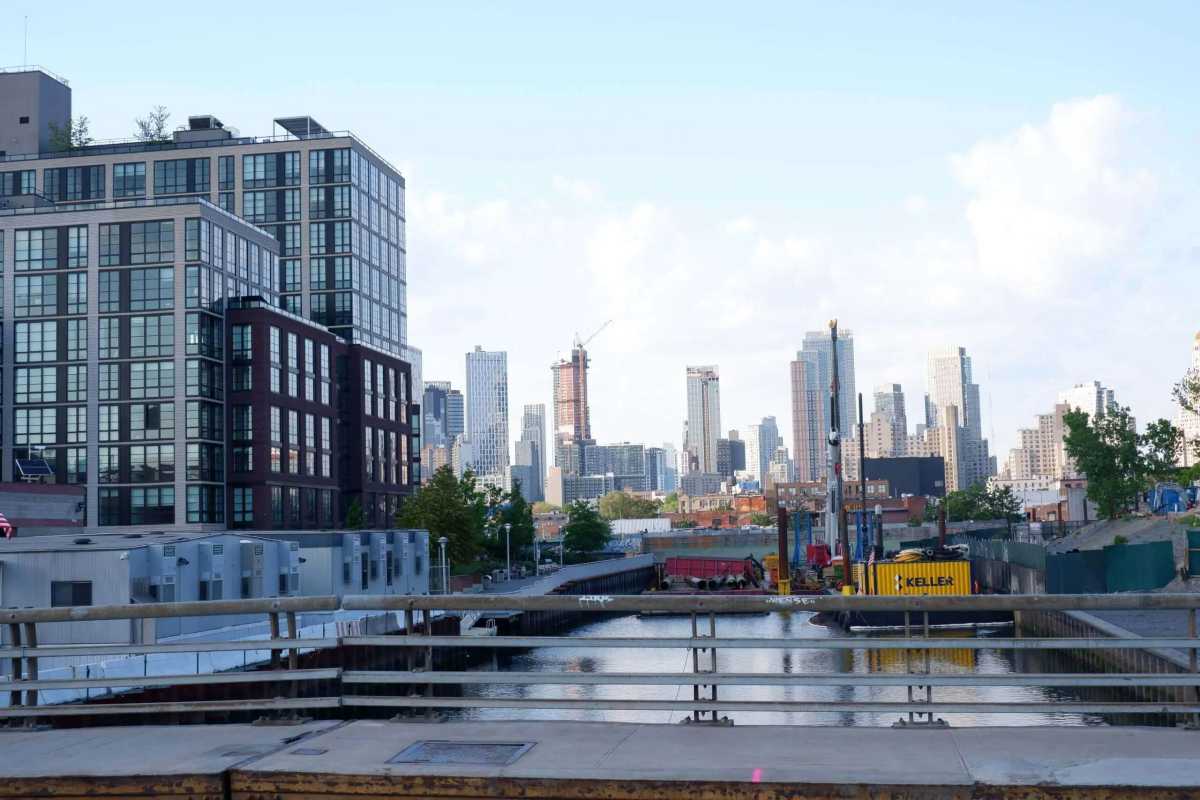Three years after the Gowanus rezoning was formally approved, its impacts are sweeping through the neighborhood. Construction is underway at dozens of sites across the neighborhood and some all-new buildings have already topped out and filled with tenants.
But the rezoning included more than just new residential buildings. When politicians green-lit the upzoning in 2021, they also agreed to abide by 56 Points of Agreement — things the city would do to ensure it would benefit the existing residents of the neighborhood, not just the approximately 20,000 new ones expected to move in as a result of the rezoning.
One of those agreements was that the city’s Department of Small Business Services would support the creation of a Business Improvement District. At a Nov. 14 meeting of the Gowanus Oversight Task Force, the members of the BID’s steering committee formally made their pitch to the community.
Why a BID?
When the Gowanus rezoning — formally known as the Gowanus Neighborhood Plan — was being developed, working groups met with city officials to discuss their primary concerns and priorities, explained Emily Bachmann, a senior planner with the city’s Department of City Planning.
Some themes emerged: the working groups wanted to prioritize public open spaces, a lively and accessible waterfront, climate-focused design and stormwater protections, local businesses, and local arts and artists.
“As I see the developments go up around me, I’m concerned about what investment is going to go into the community, and I’m worried that Gowanus will lose its unique character, and just become sort of gutted and generic,” said Lisa Lightbody, a member of the BID steering committee. “I know the BID won’t solve that, but bringing additional resources to invest in greenspaces and help the community try to create more community in this phase it’s moving into is really our best shot at it.”


A BID, with its own funding and a specific zone of responsibility, can be “sustainable way to provide the supplemental services that go above and beyond what the city is able to provide,” said Leslie Velazquez, director of BID Development and Legislation at SBS.
Steering committee member Andrea Parker, who is also the executive director of the Gowanus Canal Conservancy, said the BID has been in the works since 2021. Now, they’re in the outreach and balloting phase — letting community members know about the push to form a BID and gathering support. In order for the BID to be created, 51% of commercial tenants and property owners will need to vote in favor of it.
A 2022 community needs assessment yielded relatively few surprises, Parker said. Of 380 respondents, 91% said they were worried about stormwater management and flooding. Respondents also cited pedestrian and bike safety, enhanced sanitation services, public art, and community input on designs for public space as priorities.
Some of those issues are common throughout the city. Some are specific to Gowanus, a flood-prone neighborhood on the banks of an active federal Superfund site. While the city is improving stormwater infrastructure in the nabe, flooding will continue to be a problem as the climate changes, Parker said.
Gowanus is also home to dozens of Brownfield remediation sites, many of which will eventually be cleaned up and built on.
“We’ve also seen, as the remediation and construction processes have moved forward in the neighborhood, there can be a lack of comprehensive information about the processes, and really a lack of coordinated response to issues that arise,” Parker said.
To that end, the BID would provide general advocacy regarding climate and flood-related capital projects and city planning — and would also provide on-the-ground flood mitigation support for ground-floor businesses and tenants, as well as gather resources and information on remediation and construction.
Another Gowanus-specific concern is the waterfront esplanade. The developers building right along the Gowanus Canal are required to construct their part of the public esplanade, which will eventually encompass seven acres. Parts of the esplanade are already finished and open to the public.

But since each section has a different owner, maintenance can be inconsistent, Parker said.
“We’ve also seen from the rezoning in Williamsburg/Greenpoint that a lack of coordinated maintenance can lead to dirty and inaccessible public spaces that really don’t serve the larger community,” she added.
The BID would then take on responsibility for coordinating the maintenance of all seven acres, including sanitation, horticulture, and minor repairs.
As for the BID’s namesake, local businesses, it would help out with marketing, promotion, sanitation and other services, Parker said, to support existing local businesses while making the nabe appealing for new ones.
“There’s a huge concern in the neighborhood about the loss of neighborhood identity,” she added. “The BID needs to leverage all of this ongoing investment to support the incredible arts and culture that we already have in the neighborhood.”
She envisioned displaying work from local artists around the neighborhood, supporting small artists’ markets, and providing grant funding for local groups and artists.
Where does the money come from?
BIDs are funded by fees collected from its members, and the Gowanus BID’s steering committee has built a structure it feels is “equitable,” depending on the type and location of a building.
Residential buildings pay the lowest fee — $1 per year. Properties considered to be part of the “Gowanus Mix” would owe $0.0625 per square foot, in an effort to protect existing industrial and arts buildings.

The properties with the highest fees are the waterfront residential buildings, most of which are luxury apartments. Those buildings would be charged $0.40 per square foot, with an additional charge per square foot of public waterfront esplanade — which would be used exclusively to care for the esplanade.
In the first year, the BID would have an estimated budget of $2.7 million, Parker said. Its maximum budget would be about $4.7 million.
Sam Alison-Mayne, a steering committee member and co-founder of the local development firm Tankhouse — which has two projects in the works in Gowanus, including one on the canal — said it was “incredibly important” to have an organization, like a BID, to protect those investments.
“I think there’s always a bit of a concern, when there’s a huge investment in the public realm, that that investment stays in service of the community,” he said. “Because you often see places that are transformed, but then you fast-forward ten years and it starts to be a little confusing on… who’s benefitting from that. And it’s often the case that it’s not necessarily the people that live there.”
It’s rare, Lightbody added, that a community would have the opportunity to require continued financial investment from developers, year after year, after they’ve finished construction.

“There’s been a lot of development in in this area, there’s been a lot of pain for neighborhood residents with that development,” said committee member Grace Freedman. “But this is a really great opportunity to finally bring more attention and resources to this area, not just the brand-new developments, but the people who have lived here for a long time.”
The steering committee will continue to do community outreach over the next several months, Parker said, sending out mailings to all property owners, knocking on doors, and hosting information sessions. They hope to reach 51% support by next summer.
“This would enable the BID to be formed by spring 2026, which is when many of the new developments will open and thousands of new residents — and their trash — will move into the neighborhood,” she said.


























